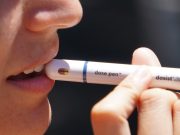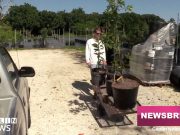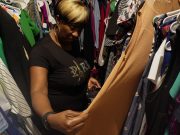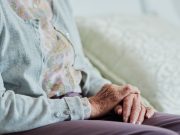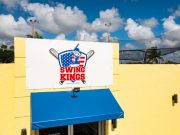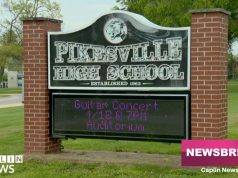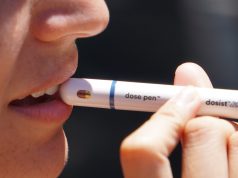More than 100,000 people work outside in Miami-Dade County — the most of any county in the state. Some harvest crops that fill grocery produce aisles, some build skyscrapers that tower above downtown and some tend lawns that line suburban streets.
All of them must battle the scorching sun — increasingly, in months extending beyond summer.
“These guys really are on the front lines of heat,” said Hector Alvarez, operations manager at Bob Hilson & Company Roofing. “They’re seasoned, but that doesn’t mean they’re immune.”
The toll extreme heat takes on South Florida, often overlooked next to the devastating threat of monster hurricanes, are serious and far-reaching. Each year, hundreds of people in Miami-Dade alone are hospitalized for heat stroke, heat exhaustion, dehydration and other heat-related illnesses. On average, heat kills 34 people a year, according to the county’s extreme heat action plan.
The economic losses from health problems are staggering. Extreme heat causes more than $10 billion in annual losses thanks to lower labor productivity, according to the Adrienne Arsht Rockefeller Foundation Resilience Center. And that’s not even factoring in the soaring energy costs of cooling homes and businesses.
Scientists expect climate change to crank up the heat even more. In 1960, Miami-Dade saw 85 days with temperatures above 90. Today, it’s 133. By 2050, that could jump to 187. By then, the Resilience Center predicts the labor losses from extreme heat will double to $20 billion a year.
Who’s looking out for South Florida workers? So far, they’re on their own. Legislators and regulators at the federal, state and local level have spent years discussing rules to protect outdoor workers, such as legally requiring employers to give water and shade breaks when the heat index crosses a certain threshold, but the measures always seem to melt away.
There is no denying the impact of heat in South Florida, and over the next year, The Herald will produce a series of stories focusing on extreme heat, the most clear and present threat of climate change. It’s a day-in and day-out challenge for the people most at risk, South Florida’s outdoor work force. From farmers to fishing guides, they are all feeling the rising heat.
The Roofer
On a May afternoon, Gilberto Lujano, 49, mops 550 degree tar onto a pitched roof. Heat envelops him from every angle. There’s no shade to block the sun, and the roof radiates heat up through Lujano’s boots.
“This is nothing,” Lujano said. “When July and August come, if the temperature reads 90 or 95, then up here it’ll be 100 or 110 degrees.”
It’s a dangerous job. In his four years working as a roofer, Lujano has seen three of his co-workers hospitalized for heat exhaustion. “I tell all the new guys, if you start to feel bad, get down from the roof and stay down,” he said. “Once you start to feel chills and cramps, it’s time to get in the shade, drink water, drink Gatorade, and rest until your strength returns.”
But not everyone listens. Lujano remembers a time when he saw one of his co-workers showing signs of severe dehydration. “We told him, ‘Hey, go down and drink water,’” Lujano said. “But he said, ‘No, I can do it. I can do it.’”
Finally, he stopped to gulp down some water — but it was too late. “We started to see that he was changing color. He was pale, pale, pale, and he wasn’t walking right,” Lujano said. “Then he started to vomit.”
It took three people to carry the sick roofer down a ladder. They laid him out in the shade and called an ambulance while he dry heaved.
“A lot of people say they’re accustomed to the heat,” said Lujano. “But your body never gets accustomed to it. Your mentality might change, but your body is the same as any other body.”
The Farmer
Felipe Ocampos and Delia Rodriguez, both 72, have spent the past two decades working on farms and nurseries in South Florida. Before immigrating to the U.S. in 2001, they worked outdoor jobs in Mexico. They know well the feeling of working outside on an especially hot day. “You feel like you’re suffocating,” Ocampos said. “You can’t breathe.”
Ocampos remembers the hottest day he ever worked. It was soon after he arrived in the U.S., while he was working on a big farm for a major landowner. The watch he wore had a built-in thermometer. Ocampos said it read 105 degrees in the sun.
That day, Ocampos was bent over, planting seedlings in long rows. “I felt like I was burning,” he said. “But if I stood still, it was worse. I had to work faster because as long as I was moving, I could create my own breeze and cool off a little.” “
So I was just thinking, ‘Go! Go! Go! Plant! Plant! Plant!’” he said.
“All that was for the boss,” he said. “That was all profit for him.”
The couple saved all they could and in 2007 they started their own nursery on leased land in Homestead. Every few years, they’ve had to relocate when landlords raised their rent or ended their lease. They’re now starting over in their fifth location, which they rented in January.
“It’s hard for us because we’re old and tired now,” said Rodriguez. “The years have passed us by.”
Both of them have gotten eye surgeries and struggle with their vision. “On really hot days, I see a flash of light here,” Ocampos said, gesturing to his eyes, “and I can’t see.”
But Rodriguez said they need to work. “Really, we don’t have any other option but to keep fighting,” she said. “We have to pay the rent on this land and on our house.”
It’s hard work, lifting and bending in the heat of the day from 8 a.m. to 4 p.m. But at least, Ocampos said, they’re working for themselves.
“Now that I’m older, I can’t work outside for a boss anymore,” he said. “Here I’m happy because, finally, when I want to rest, I rest. When I want to drink water, I drink water.”
The Landscaper
Hector Benitez starts his day as a landscaper at 7 a.m. That’s when the 43-year-old and his four-person crew pile into a truck in Homestead to start their commute to Coral Gables. It often takes two hours in traffic to reach the first home they’ll be tending that day.
On a recent afternoon, Benitez perched on a ladder, carefully trimming back ivy creeping up the walls of a two-story house. Nearby, a coworker leaned over the edge of the roof with a long chainsaw to snip the vine tendrils threatening to swallow up the gutters. Overhead, the sun beat down, sapping the strength from their bodies.
“When we feel really tired and weak from sweating so much, we take a five-minute break, even though that’s not standard for the company,” Benitez said. If they don’t rest and drink water, they risk fainting, which can be dangerous if they’re up on a ladder or a roof holding cutting tools.
Even Benitez, who drinks eight bottles of water a day, can still wind up with a nagging headache at the end of the day. Sometimes, the headaches he picks up at work follow him home. “When it’s been a really hard day at work,” he said, “sometimes you don’t want anybody to even talk to you.”
The Fishing Guide
Carl Ball, 58, has been fishing in Biscayne Bay all his life. Now, as a flats fishing guide, his livelihood depends on putting clients on bonefish, permit and tarpon in a small open skiff in South Florida’s shallow coastal waters.
“I’m in the sun all day long,” he said. “There’s no cover on the boat at all.”
In his younger days, he didn’t worry much about it. “It was hot, but we were more concerned about getting a good tan and being cool and being outside with no shirt on,” he said. “When I started guiding, I saw a few of the other flats guides out there were covered up from head to toe and I used to think that was ridiculous.”
“Eventually I realized, God, I need to quit being sunburned all the time,” he said.
These days — like just about every other shallow water guide in South Florida — Ball covers up: He wears closed-toed shoes, SPF-protective pants and long-sleeved shirts, a neck gaiter that covers much of his face, a baseball cap and gloves to keep the sun off his hands.
Ball says he can handle the heat of the sun out on the water. But over time, he’s seen how urban development has turned the land into a concrete oven. He said can feel the heat on the breeze when his boat passes built-up sections of Miami Beach and Key Biscayne. They are literally heat islands, which is what climatologists call intensely developed urban areas that trap heat.
“When the wind is blowing over the top of Key Biscayne in July or August, I get about halfway up the island and I can feel these warmer gusts of wind hitting me,” he said, “and I’m like, ‘Oh, great. This is what we have to look forward to when we hit that parking lot when we get back.’”
“You get downwind of Virginia Key where there’s a lot of trees and you can literally feel how much cooler it is,” he said.
The Street Vendor
At Red Road and West 84th Street in Hialeah, a busy intersection bordering the Miami-Opa Locka Executive Airport, Eddy Rivera walks between lanes of cars carrying bouquets of roses and bundles of oranges and guava.
Rivera loops up and down the lanes, keeping rhythm with the pattern of red lights, from 8 a.m. until 8 p.m. Throughout the day, he takes gulps of water out of a gallon jug he keeps in the shade of a tree on the southwest corner of the intersection. “If you don’t drink water, you faint,” he said. “Water is the most important thing there is.”
Rivera has been working as a street vendor since he immigrated to Miami last year. “When you’re a recent immigrant you have to work like this under the sun,” he said.
“I had no other way,” he said. “They offered me this job to sell flowers. I have to do it out of necessity because no one helps me. I have to work to survive.”
This story was also published in the Miami Herald



